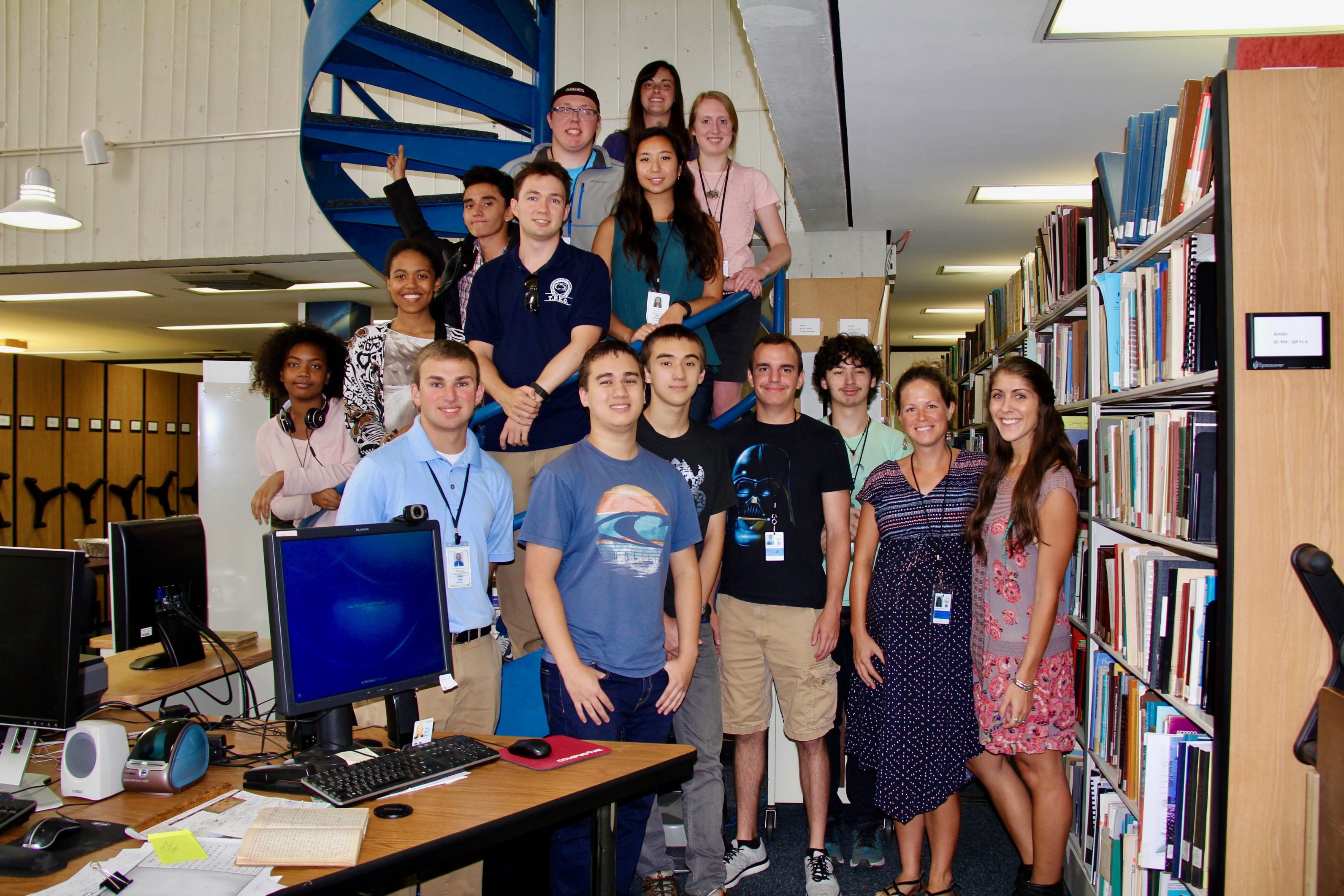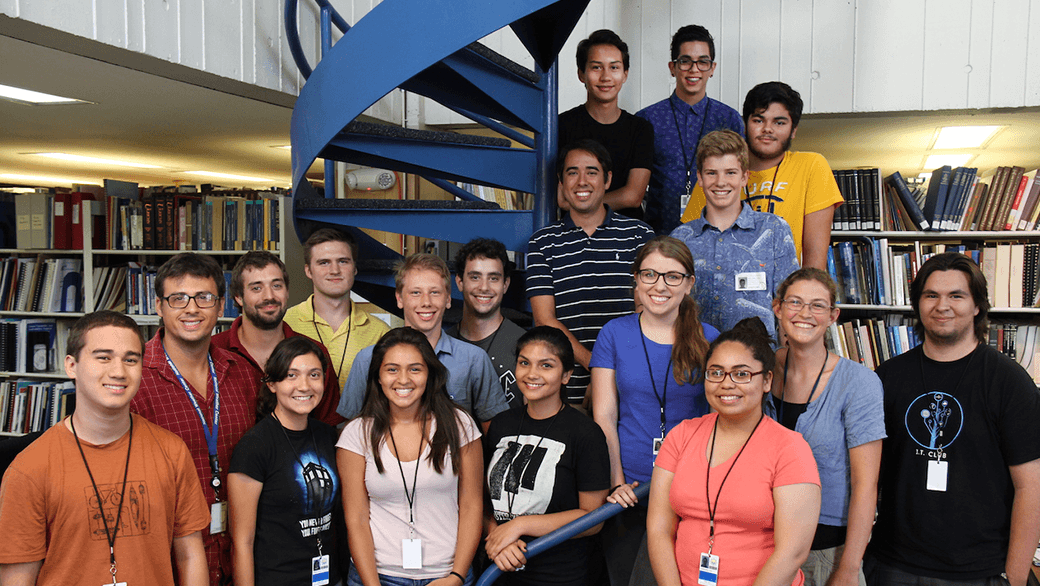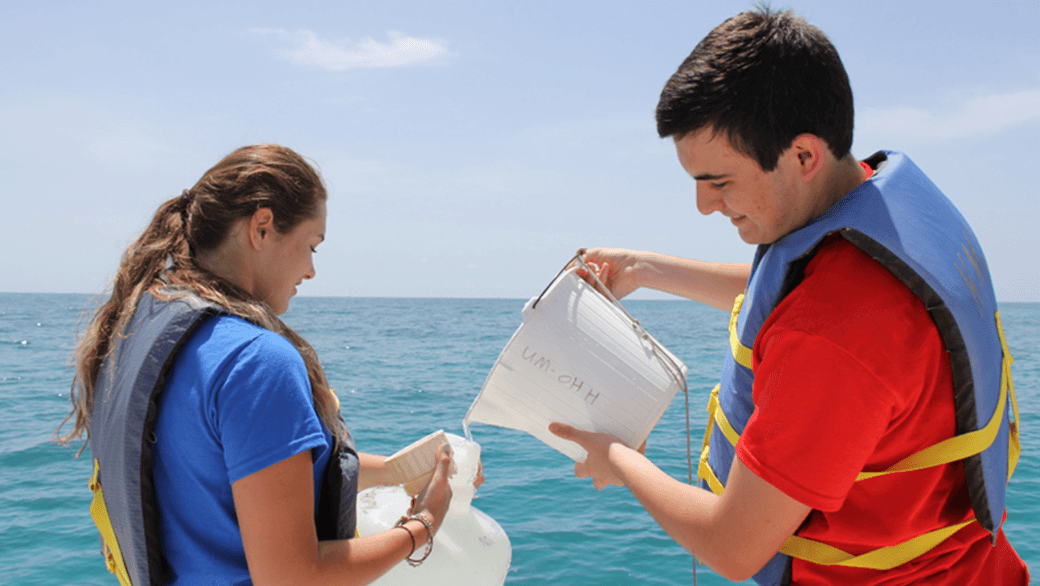Each year, NOAA AOML welcomes a group of talented students from across the country to join our team by way of summer internships. Seventeen highly motivated students have traveled to our laboratory in Miami to work alongside leading oceanic and atmospheric research scientists. NOAA internships, scholarships, and fellowships provide students with an unparalleled opportunity to develop and fine tune their research and field skills, giving them a glimpse of what it takes to establish a professional career in a federal research laboratory. Each student works side by side with a AOML mentor, who help to advise the students along their chosen scientific career paths and various research projects. Here at AOML, these career opportunities include jobs in physical oceanography, ocean chemistry and ecosystems, hurricane research, engineering, computer science and communications.
Summer Intern Season at AOML
The 2016 Atlantic Oceanographic and Meteorological Laboratories’ (AOML) cadre of summer interns inspired us with a very promising group of motivated individuals. Fourteen students came from all over the country to complete a wide array of projects in different thematic areas of AOML’s workforce; Physical Oceanography, Ocean Chemistry and Ecosystems, Hurricane Research, Engineering, and Communications.AOML is home to some of the nation’s leading scientists, and internships offer a great opportunity for students to learn alongside these experts and develop skills that they will take with them in the future. The summer internships also expose students to careers at a federal research laboratory. NOAA offices are located all across the country, so students who enjoy their summer internship can consider NOAA or other federal science agencies for future employment when they enter the workforce.
AOML Welcomes Aboard Summer 2015 Interns
AOML welcomes 22 young men and women, including new and returning high school, undergraduate, and graduate students, who are completing internships at the lab this summer. Over the course of their six to ten week internships, students will work with mentors in the fields of Ocean Chemistry & Ecosystems, Physical Oceanography, and Hurricane Research, as well as specialists in Computer Networks and Services, Administration, and Communications, to participate in field sampling efforts, perform data analysis, and create new content for internal and external websites.
AOML’s internship opportunities provide students with experiences that motivate and prepare them for careers aligned with NOAA and its industry and university partners. For many students, these internships are unique experiences that provide an opportunity to learn from some of the nation’s leading scientists. They participate in activities that support ongoing AOML research, and sometimes create new opportunities that become the foundation for their first scientific publication.
Each intern works alongside their AOML mentor to conduct research activities that match their educational interests and background. Their assigned work includes experimental data collection and processing, equipment design and testing, field research, and computer software and web content development. Some of the specific internship projects this summer include:
- water quality field sampling efforts and use of molecular techniques to assess and characterize microbial contaminants;
- examining particular storm characteristics that influence hurricane development in an effort to improve hurricane intensity forecasts; and
- observing and modeling climate fluctuations in the central and northeastern Tropical Atlantic.
Many of these projects are at the cutting edge of science and technology, and all are important to future NOAA research efforts.
The group of talented students hails from local Miami-Dade high schools and higher learning institutions such as MAST Academy, G. Holmes Braddock Senior High School, Miami-Dade College, and the University of Miami, as well as other U.S. and International universities. The group also contains three undergraduates from the prestigious Hollings Scholarship Program. Administered by NOAA, the program provides support and multidisciplinary learning experiences for undergraduate students interested in pursuing research, public service, or teaching careers in the oceanic and atmospheric sciences.
AOML Enlists Citizen Scientists for International Ocean Sampling Day 2015
Researchers with AOML’s Environmental Microbiology Lab joined a global effort to sample the smallest members of the ocean ecosystem on June 21 during International Ocean Sampling Day. Organized and led by the European Union’s MicroB3 organization and the Ocean Sampling Day Consortium, Ocean Sampling Day (OSD) is a simultaneous sampling campaign of the world’s oceans and coastal waters. These cumulative samples, related in time, space and environmental parameters, contribute to determine a baseline of global marine biodiversity and functions on the molecular level.
What are scientists looking for?
The organisms of scientific interest for the OSD campaign include microscopic Bacteria, Archaea, Fungi, Protists and viruses, collectively known as microbes. Microbes make up 98 percent of the biomass in Earth’s oceans and are responsible for most of the biological activity that takes place within it. Microbes are found everywhere, from the ocean surface to deep within rocks beneath the ocean floor. They are pervasive and can evolve rapidly in response to changes in the environment. In fact, many scientists consider microbes to be a “canary in the coal mine”, signaling local and global changes in the oceans. It is, therefore, important to acquire information from across the globe on this vast community of organisms, against which future changes can be observed and measured.
2014: The first global OSD effort
During the 2014 Ocean Sampling Day event, over 180 scientific teams participated from all continents ranging from subtropical waters in the Caribbean to extreme environments in the Antarctic Ocean. On this day, more than 600 people all around the world took water samples from the ocean in order to identify the microbes within. Scientists used the data collected to support projects focusing on environmental microbiology parameters that describe the relationship between marine microbes and human health and the health of our local marine ecosystems. This data will also provide insights to the ocean economy through the identification of novel, ocean-derived biotechnologies.
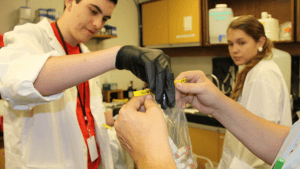
Researchers with AOML’s Environmental Microbiology Lab joined a global effort to sample the smallest members of the ocean ecosystem on June 21 during International Ocean Sampling Day. Organized and led by the European Union’s MicroB3 organization and the Ocean Sampling Day Consortium, Ocean Sampling Day (OSD) is a simultaneous sampling campaign of the world’s oceans and coastal waters. These cumulative samples, related in time, space and environmental parameters, contribute to determine a baseline of global marine biodiversity and functions on the molecular level.
What are scientists looking for?
The organisms of scientific interest for the OSD campaign include microscopic Bacteria, Archaea, Fungi, Protists and viruses, collectively known as microbes. Microbes make up 98 percent of the biomass in Earth’s oceans and are responsible for most of the biological activity that takes place within it. Microbes are found everywhere, from the ocean surface to deep within rocks beneath the ocean floor. They are pervasive and can evolve rapidly in response to changes in the environment. In fact, many scientists consider microbes to be a “canary in the coal mine”, signaling local and global changes in the oceans. It is, therefore, important to acquire information from across the globe on this vast community of organisms, against which future changes can be observed and measured.
2014: The first global OSD effort
During the 2014 Ocean Sampling Day event, over 180 scientific teams participated from all continents ranging from subtropical waters in the Caribbean to extreme environments in the Antarctic Ocean. On this day, more than 600 people all around the world took water samples from the ocean in order to identify the microbes within. Scientists used the data collected to support projects focusing on environmental microbiology parameters that describe the relationship between marine microbes and human health and the health of our local marine ecosystems. This data will also provide insights to the ocean economy through the identification of novel, ocean-derived biotechnologies.
Where are AOML scientists sampling?
This year, AOML will coordinate and sample ten OSD sites across the country. In addition to the 2014 sites in the Florida Keys, Ft. Lauderdale, Tampa Bay, La Jolla, California, and Horn Island, Mississippi, AOML will coordinate five new sites spread across the Florida peninsula from Pensacola to Miami. Sampling sites are expected to be monitored long-term as part of the international Genomic Observatories Network and the resulting database will be accessible to the public.
MyOSD: The citizen scientist component
OSD organizers have amended the citizen science component for this year’s event, allowing individuals from all over the globe to collect samples in their backyard using handy sampling kits. This component, called MyOSD, gives individuals the chance to help scientists unravel the mysteries of the marine microbial world by collecting important environmental data such as latitude, longitude, temperature, salinity, pH and wind speed.
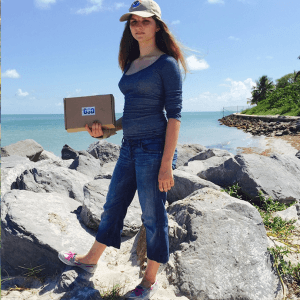
A citizen scientist from MAST Academy samples a site on Key Biscayne with a MyOSD kit. Image Credit: NOAA
AOML has coordinated and provided kits to a number of citizen science groups in Florida and California, including organized youth groups, citizen science organizations, educational centers, and outreach groups. Samples collected will represent a variety of different marine ecosystems including the open ocean, beaches, coral reefs, and estuaries.
We are excited to be working with a number of citizen scientists this year to expand our sampling effort and help contribute to our understanding of the ocean’s biodiversity said AOML. “
-Microbiologist Dr. Chris Sinigalliano
A baseline for the future
With the combined effort of researchers and citizen scientists, OSD 2015 continued the initiative to collect and share crucial information that can be used as a reference for generations of experiments to follow in the coming decades. Additionally, the data analysis procedures being developed for OSD are driving the field forward, but it is clear that much remains to be discovered about the microbial world. Scientists hope that such large-scale projects that provide an “ecological snapshot” become increasingly more common as they are essential for understanding the complexity of Earth’s systems.
Originally Published by Edward Pritchard, 2015
Summer Interns Help Create a Hands-on Outreach Demonstration
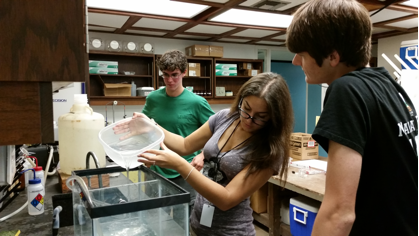
Three summer interns collaborated with AOML’s Physical Oceanography Division to develop a hands-on outreach demonstration experiment that will be a useful tool to educate future visiting K-12 students. The students presented their demonstrations and associated research as a conclusion to their 8 week-long summer internship with NOAA scientists at AOML. The students attend MAST Academy, a Maritime and Science Technology magnet high school in Miami-Dade county co-located with AOML on Virginia Key. The interns’ experiment illustrates some of the effects of changing salinity on density and the buoyancy of objects. It will help teach students about topics in physical oceanography such as the Atlantic Meridional Overturning Circulation (AMOC), the Mediterranean Sea outflow, and how floats, drifters, and gliders use density and buoyancy to determine their positions in the water column.
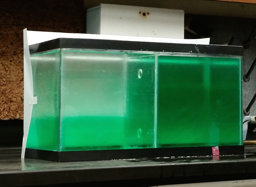
Saltier (denser) water (colored green) forms a layer underneath the fresher (lighter) water after the stoppers are removed from the center divider. (credit: NOAA/AOML)
To begin the demonstration, the interns first divided a rectangular fish tank into two halves using a plexiglass panel with closed stoppers in holes near the top and bottom. One half was filled with room temperature salt water, while the other half was filled with warm fresh water. They dropped objects of varying densities into the divided tank in order to see which would float, and which would sink. For example, a small flask filled with fresh water sank to the bottom of the lighter fresh water but floated on top of the denser salt water. After using green food coloring to mark the denser salt water, the interns then removed both stoppers. This created a simple overturning circulation effect, where water flowed from the fresh to salty side of the tank through a hole near the top, and flowed from the salty to fresh side of the tank through the hole near the bottom. Eventually, the circulation resulted in a layer of fresh water lying above a layer of salt water.
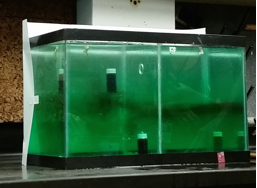
A small flask filled with fresh water and a small amount of air released at the top of the tank floats near the interface between the fresher (lighter) and saltier (denser) layers. Heavier flasks filled completely with fresh or salty water sink to the bottom on both sides of the tank. (credit: NOAA/AOML)
The interns then dropped flask filled with fresh water into either side of the tank, they observed it dropping through the fresh water and floating at the top of the salt-water layer. To further illustrate this effect, a balloon filled with warm, lighter fresh water and red food coloring was placed into the tank and held near the bottom. When the balloon was popped in the lower layer, the colored water mixed with the surrounding salt water, becoming brackish, and rose part way to the surface, finally settling at the saltwater-freshwater interface.
“The balloon popping is my favorite part,” said Ryan Winslow, one of the MAST interns. “It shows how the liquid is dispersed in a random pattern but then reorganizes itself to create a medium between the two types of water”
In future repetitions of these experiments more precise measurements of the temperature and salinity of the water could be made, allowing for a better means of calculating the density differences between the water in the tank and in the various objects used. During the buoyancy experiments, scientists could also better account for the effects of the weight of the objects (jars, balloons, etc.) themselves and any air that was contained within them.
In addition to their outreach demonstration, facilitated by AOML oceanographer Renellys Perez and ocean engineers Grant Rawson and Andy Stephanick, the three interns worked with other PhOD scientists this summer to learn about some of the research conducted by the division. Michelle Mestres worked with Gustavo Goni and Libby Johns to learn about the emerging field of Glider technology. Ryan Winslow interned with Molly Baringer and examined ways in which data from the Repeat Hydrography program can be used to study heat content in the ocean. Arturo Toro assisted the engineering group with a variety of ongoing projects.
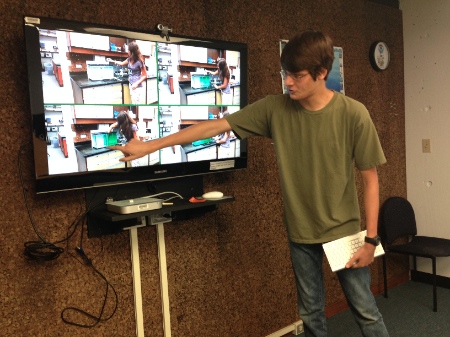
explains what he learned durning his summer at AOML. (credit: NOAA/AOML)
Originally Published August 2014 by Shannon Jones
